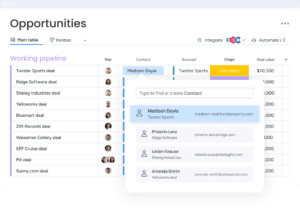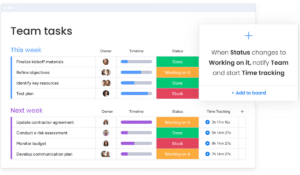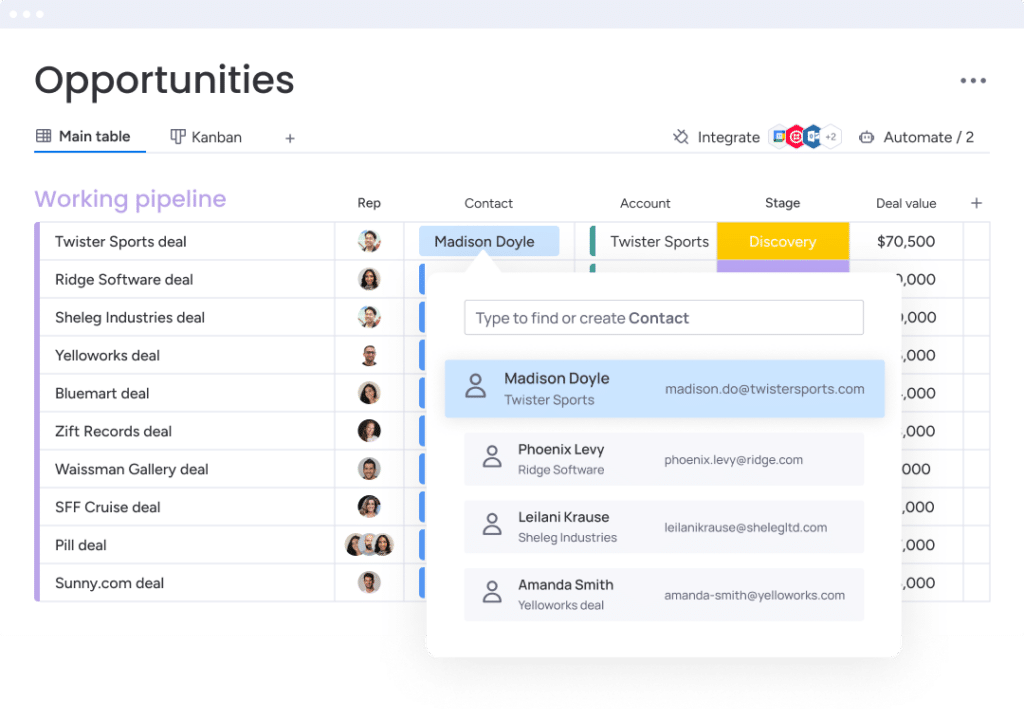Customer Relationship Management (CRM) systems have become an essential tool for businesses aiming to build and maintain strong relationships with their customers. By offering a centralized platform for managing leads, contacts, and sales opportunities, CRMs enable sales teams to work more efficiently and effectively. However, to truly unlock the potential of these systems, tracking CRM activities is crucial. In this blog post, we’ll explore how tracking CRM activities can help you streamline your sales strategy. Which in turn will lead to increased productivity and more successful outcomes.
Brief overview of CRM systems
CRM systems are software applications designed to help businesses manage customer interactions and data throughout the customer lifecycle. They provide a unified platform for organizing, automating, and synchronizing sales, marketing, customer service, and technical support processes. With CRM systems in place, businesses can access critical information about their customers and potential leads. This enables them to make better-informed decisions and provide personalized customer experiences.
Importance of tracking activities within CRM systems
While CRM systems offer many valuable features, one of their key benefits is the ability to track and monitor activities related to customer interactions. By consistently tracking these activities, businesses can gain valuable insights into their sales processes, customer behavior, and overall performance. This information can then be used to identify areas for improvement, optimize strategies, and ultimately, drive business growth.
Introduce benefits of streamlined sales strategy
A streamlined sales strategy is essential for businesses to succeed in today’s competitive market. By effectively tracking CRM activities, organizations can enhance their sales processes, improve team collaboration, and ultimately, achieve better results. In the following sections, we will dive deeper into the benefits of CRM activity tracking. And discuss how it can help you streamline your sales strategy.
Understanding CRM Activity Tracking
To fully harness the power of CRM systems, it’s essential to understand the concept of activity tracking and how it can provide valuable insights into your sales process. In this section, we’ll discuss the types of activities you should track within your CRM system. Additionally, we’ll discuss the value of accurate, real-time data for optimizing your sales strategy.
Definition of CRM activities
CRM activities refer to any interaction or event associated with your customers or potential leads. These activities can include various touchpoints such as phone calls, emails, meetings, social media interactions, and more. By tracking and logging these activities in your CRM system, you can create a comprehensive view of your customer relationships and sales pipeline, enabling you to make data-driven decisions and adapt your strategies as needed.
Types of activities to track (calls, emails, meetings, etc.)
There are numerous activities that should be tracked within your CRM system. Some of the most common and important ones include:
- Phone calls: Record the date, time, duration, and outcome of each call, as well as any follow-up actions required.
- Emails: Track sent and received emails, including open and click-through rates, to better understand customer engagement.
- Meetings: Log details of face-to-face and virtual meetings, including attendees, key discussion points, and follow-up tasks.
- Tasks and reminders: Monitor the progress of assigned tasks and set reminders for future activities.
- Social media interactions: Track customer engagement on social platforms, such as likes, shares, comments, and direct messages.
- Notes and documents: Attach relevant files, notes, or documents to customer records for easy access and reference.
The value of accurate data and real-time insights
Accurate and up-to-date activity tracking is crucial for extracting valuable insights from your CRM system. Real-time data enables your sales team to respond promptly to customer needs, identify emerging trends, and make informed decisions that drive better results. Additionally, having a complete view of customer interactions allows for improved collaboration among team members. This ensures that everyone is aligned and working towards the same goals. By prioritizing activity tracking within your CRM system, you can create a solid foundation for a streamlined and effective sales strategy.

Benefits of Streamlining Sales Strategy through CRM Activity Tracking
Tracking CRM activities not only provides a wealth of data but also leads to a more streamlined sales strategy that drives better results. In this section, we’ll discuss the various benefits of implementing CRM activity tracking and how it can positively impact your sales performance.
Enhanced visibility into sales pipeline
CRM activity tracking offers increased visibility into your sales pipeline, allowing you to easily monitor the progress of leads and opportunities. This comprehensive view helps you identify bottlenecks, prioritize high-value prospects, and allocate resources more effectively. With a clear understanding of your pipeline, you can make data-driven decisions to optimize your sales process and achieve better outcomes.
Improved team collaboration and communication
When all customer interactions and activities are tracked within your CRM system, team members can access a complete and accurate record of each customer relationship. This transparency enables better collaboration and communication among your sales team, as everyone has access to the same information. Improved collaboration ensures that all team members are aligned and working towards common goals, ultimately resulting in a more efficient and effective sales process.
Increased efficiency and productivity
By tracking CRM activities, you can identify inefficiencies in your sales process and implement improvements to enhance productivity. For example, you may discover that your sales team spends too much time on manual data entry or updating records. By automating these tasks or streamlining processes, you can free up time for your team to focus on more high-value activities. These include engaging with prospects and closing deals.
Better forecasting and decision making
With a wealth of data at your fingertips, you can make more accurate forecasts about future sales performance and make informed decisions about your sales strategy. CRM activity tracking allows you to identify trends and patterns in customer behavior. This can help you adapt your approach and tailor your messaging to better resonate with your target audience. By making data-driven decisions, you can optimize your sales process and drive better results.
Higher lead conversion rates and customer retention
CRM activity tracking can help you understand the needs and preferences of your customers more effectively. This in turn leads to improved lead conversion rates and higher customer retention. By analyzing tracked data, you can identify the most effective tactics and strategies for engaging with your audience. This results in more closed deals and long-term customer relationships.
Best Practices for Implementing CRM Activity Tracking
To reap the full benefits of CRM activity tracking, it’s essential to implement best practices that ensure accurate and consistent data collection. In this section, we’ll discuss some key strategies for setting up and maintaining effective activity tracking within your CRM system.
Setting up activity tracking in your CRM system
Before you can start tracking activities, you’ll need to configure your CRM system to capture the relevant data. This may involve customizing activity types, creating custom fields, or setting up automation rules. Be sure to involve your sales team in this process, as their input can help ensure that the system is tailored to meet their specific needs and workflows.
Encouraging team adoption and consistent usage
To ensure accurate and comprehensive activity tracking, it’s crucial that your entire sales team consistently uses the CRM system. Provide training and support to help team members understand the benefits of activity tracking and how to use the system effectively. Additionally, establish clear expectations around CRM usage and hold team members accountable for keeping their records up to date.
Establishing clear activity tracking guidelines
Develop clear guidelines for tracking activities within your CRM system. These guidelines should outline which activities should be tracked, how they should be categorized, and any specific details that need to be captured. Having a consistent approach to activity tracking will make it easier to analyze your data and draw meaningful insights.
Regularly reviewing and analyzing tracked data
Activity tracking is only useful if the data is regularly reviewed and analyzed. Schedule periodic reviews of your CRM data to identify trends, patterns, and areas for improvement. Encourage your sales team to use the data to inform their strategies and decision-making. Additionally, provide them with the tools and support they need to make data-driven adjustments to their sales approach.
By following these best practices, you can ensure that your CRM activity tracking is effective, accurate, and valuable. This in turn will lead to a more streamlined sales strategy and improved results.

Leveraging CRM Activity Data to Improve Sales Performance
Once you have implemented effective CRM activity tracking, it’s essential to leverage the collected data to drive improvements in your sales performance. In this section, we’ll explore how to use the insights gained from CRM activity tracking to optimize your sales processes and achieve better results.
Identifying patterns and trends in customer behavior
By analyzing your CRM activity data, you can identify patterns and trends in customer behavior that can help inform your sales approach. For example, you may notice that certain types of outreach are more effective than others or that specific customer segments respond better to particular messaging. By understanding these patterns, you can tailor your sales and marketing efforts to better engage with your target audience.
Adjusting sales approach and tactics based on data insights
Use the insights gained from CRM activity tracking to make informed adjustments to your sales approach and tactics. This could involve refining your sales pitch, improving your email templates, or modifying your lead qualification criteria. By continually refining your approach based on data-driven insights, you can enhance your sales performance and increase your chances of success.
Optimizing customer engagement and nurturing strategies
CRM activity data can also help you optimize your customer engagement and nurturing strategies. By understanding how your customers interact with your content and which touchpoints drive the most engagement, you can develop more effective campaigns and outreach efforts. Additionally, CRM activity tracking can help you identify the most opportune times to engage with customers and leads. This in turn allows you to maximize the impact of your communications.
Reinforcing a data-driven sales culture within the organization
Finally, leveraging CRM activity data to improve sales performance requires fostering a data-driven sales culture within your organization. Encourage your sales team to actively engage with the data, share insights, and collaborate on strategies for improvement. By promoting a culture of data-driven decision-making, you can ensure that your sales team is continually striving for excellence and working towards shared goals.
By leveraging CRM activity data, your organization can make more informed decisions, optimize sales processes, and ultimately, improve overall sales performance.
Conclusion
Implementing CRM activity tracking can have a profound impact on your sales strategy and overall business performance. By consistently monitoring and analyzing customer interactions, your organization can gain valuable insights that inform your sales approach, enhance team collaboration, and drive better results.
Recap of key benefits
To recap, some of the key benefits of CRM activity tracking include:
- Enhanced visibility into the sales pipeline
- Improved team collaboration and communication
- Increased efficiency and productivity
- Better forecasting and decision-making
- Higher lead conversion rates and customer retention
Emphasizing the importance of a data-driven approach
A data-driven approach to sales is crucial in today’s competitive business landscape. By leveraging CRM activity data, your organization can make more informed decisions, optimize sales processes, and ultimately, improve overall sales performance.
Encouraging businesses to adopt CRM activity tracking
In conclusion, adopting CRM activity tracking should be a priority for any business looking to streamline its sales strategy and achieve better results. By implementing best practices and leveraging the insights gained from CRM activities, you can set your organization on a path to success and sustained growth.
Get started with CRM activity tracking today
Are you ready to harness the power of CRM activity tracking for your business? As a partner of monday.com, Omnitas Consulting is here to help. Our team of experienced professionals can guide you through the process of implementing CRM activity tracking using monday.com‘s powerful platform, providing valuable insights to optimize your sales strategy.
Don’t miss out on the opportunity to drive better results and grow your business. Contact us today to get started with tracking your CRM activities and unlocking your organization’s full potential through monday.com.
























